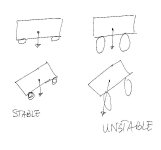Re: Where\'s Our Tractors\' Center Of Gravity?
Hi,
<font color=blue>what you should be more concerned with when dealing with any slope is the change in rotatinal speed. In other words a chanfe in position as the wheel goes into a hole or climbs up a rock. The sudden cahnge will cause a roll over fast then just increasing the slope you are driving on.</font color=blue>
I agree totally that speed is critical to safety when traversing a slope! Slower is better...no doubt about it at all.
BUT I still would like to have an idea about how stable or unstable my tractor may be. Must just be my nature!
A tractor with a wider stance and a lower center of gravity will certainly be more likely to survive that hole or bump that it hits while crossing a slope. If I had two tractors, and knew the center of gravity was higher on one than the other, while the wheel spread was the same, I would certainly be inclined to drive the less stable one slower than the other across a slope.
I guess I have trouble dealing with unknowns! If I desire to buy something, I need to know the price before I agree. I can set the water heater temperature in the house at a point where it is hot enough, but not hot enough to scald someone...if I lift with a chain or cable, I want to know the load rating.
Seems like it may be conservative to figure that the center of gravity would be between the top of the tires and the top of the rear wheel rims. I will have to do a couple simple calculations and see what come out.
All this means nothing really, as I don't think my behavior will change regardless of what things calculate out to be.
I wish I had the capability to weigh the tractor at different angles! But I can�ft even weigh it level! Don�ft have any scales that big. Would be neat to see where the real center of gravity is. If I ever come across those scales, Turfman... /w3tcompact/icons/smile.gif
I guess I keep thinking about how I never really knew how far I could go on my bicycle when I was a kid until I fell off it a couple times. And now that I�fm in my second childhood with a new tractor...I don't want to fall off to learn the limits I can operate in, but still would like to have an idea of what they are.
Bill in Pgh, PA
